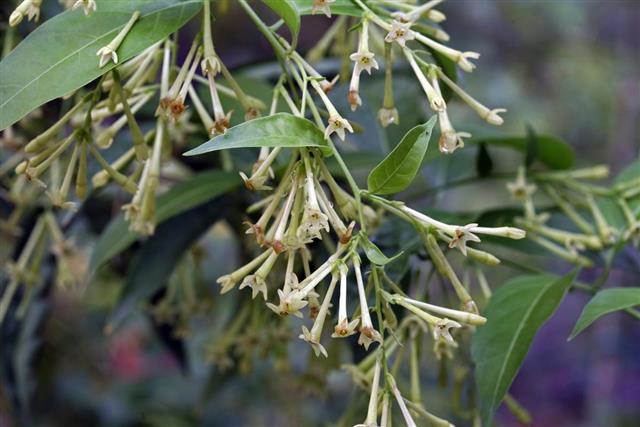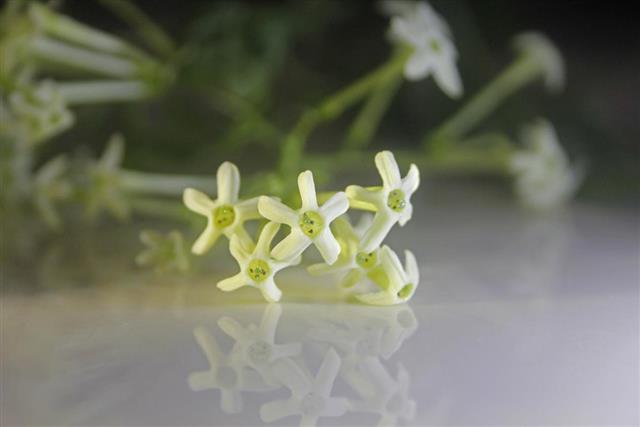
One of the most fragrant flowers in all Creation, night-blooming jasmines are a favorite among gardeners due to their innocent beauty and intoxicating perfume. Read all about night-blooming jasmine care in the following article.
Plants that wake when others sleep. Timid jasmine buds that keep their fragrance to themselves all day, but when the sunlight dies away let the delicious secret out to every breeze that roams about.
~ Thomas Moore
Almost all nocturnal blooming flowers share two common characteristics – light coloring and intoxicating perfume. Flowers that bloom while the sun is still up, on the other hand, come in a diverse variety of shades and hues and often have either a very light or an overpoweringly heavy perfume. Nocturnal flowers, on the other hand, smell just right – strong enough for you to know they have bloomed and light enough so as not to interfere with any other smell around you. It’s as if these flowers have struck a harmonious deal with night that the perfume that emanates from them would only enhance the feel of the dark, silent hours rather than appear discordant to them!
The night-blooming jasmine flowers are no exception to this phenomenon and if your residence happens to be in close vicinity of night-blooming jasmine shrubs, you already know what the term smells-like-heaven means when you throw open the windows late at night when the neon lights start getting put off one by one and half of the world prepares to go to sleep! If you’re interested in gardening and have a lawn or flower bed on your premises, you might want to plant some night-blooming jasmine – imagine, taking a relaxing walk on a moonlit night in your garden with air fragrant with the intoxicating scent of jasmine permeating your entire being….. That being said, here’s all you need to know about night-blooming jasmine care.
Night-blooming Jasmine Plant Care
You can either grow these nocturnal flowering shrubs from night-blooming jasmine plant seeds or from stem cuttings prepared for cultivation purposes. When planting seeds, it is best to use ready pods containing seeds and plant them in new potting soil that has been watered and allowed to drain completely so that the soil is sufficiently damp but neither dry nor totally wet. Planting stem cuttings, however, is considered best as the plant growth is faster and better. In this case, make a soil mixture that contains peat moss and clean, sifted sand in a 2:1 ratio. The peat moss retains the necessary moisture and regulates soil temperature while the sand drains out all unnecessary moisture. Following are some other points that you must keep in mind when growing night-blooming jasmine bushes:-
♣ When cultivating these shrubs, make sure they get at least 4 – 6 hours of sunlight. Any more or any less sunlight would be detrimental to their health during the growing stage. These shrubs need to be kept in shade most of the time as exposure to strong sunlight and for long hours makes the leaves wilt.
♣ If you’re planting a stem cutting, you must water the soil immediately after. This keeps the soil packed around the cutting. In case of planting seeds in potting soil, the seed containing pods must be pressed into the top of the damp soil.
♣ Make sure you don’t irrigate the soil too frequently as excess moisture can cause the roots to rot. Water the plants only when the surrounding soil appears completely dry which means watering them every five to six days suffices.
♣ Use a fertilizer that has a high phosphorus content as it encourages the flowers to grow and bloom healthily. After all, it is these fragrant flowers that hold all the appeal, hence, maintaining the health of flowers is very important.
♣ Night blooming jasmines react poorly to excess temperature, be it extreme heat or extreme cold. That’s why, besides making sure to keep them away from too much sun exposure, also keep in mind that they are not exposed to winter chills and frost. Being tropical plants, night-blooming jasmines cannot stand frost and can die if exposed to a temperature lower than 8°C.
♣ Prune the shrubs regularly and remove dead twigs and wilted leaves to keep the blossoms from diminishing in number and size and to allow the healthy branches and leaves to have more access to fresh air and sufficient sunlight.
♣ Night blooming jasmine plant diseases such as disintegration of blossoms and stunted growth of leaves and flowers may be caused by either wrong soil composition, insufficient soil nutrition, excessive watering and garden pests. Caterpillars and aphids are two of the most common night-blooming jasmine plant pests. While caterpillars feed on the leaves and cause considerable damage to the plant foliage, aphids damage blossoms and prevent them from blooming properly. As a result, most blossoms die out even before they get to bloom.
Note: Night blooming jasmine and the regular jasmine plants are totally different from one another and should not be confused with each other. Both belong to different botanical orders and cultivating and gardening guidelines differ significantly for both.
As you can see, a standard care regimen for night-blooming jasmine doesn’t require much efforts on your part. You just need to follow the standard gardening measures that apply to most tropical plants and shrubs. Temperature and moisture are the two primary factors that need to be taken care of on a regular basis. Even if a full-grown plant does appear to have wilted under frost during winters, don’t lose heart as it will resurrect itself on the first hint of the refreshingly lukewarm spring breeze. Spring and early summers are the times when your nocturnal jasmine will be in full bloom, turning your garden into a fragrant paradise that will draw a lot of nature’s creatures such as birds, butterflies, bees and squirrels.



